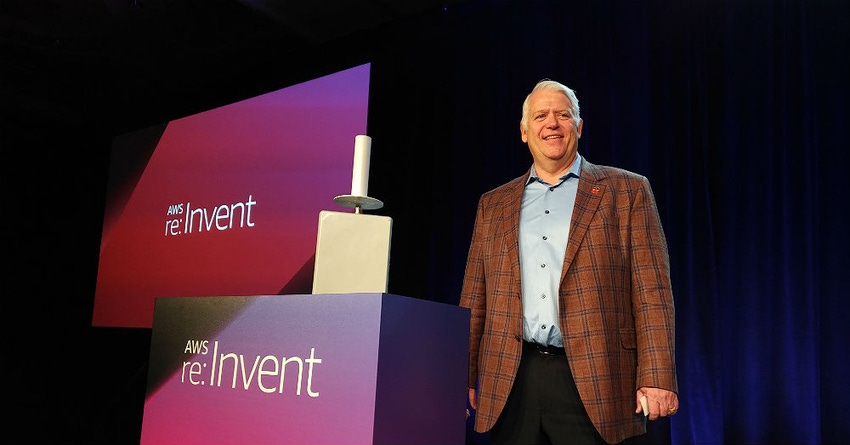At re:Invent, AWS Announces Services with Open Source, IoT Focus
News from AWS re:Invent will please partners with IoT practices and customers looking for cloud cost containment.
November 28, 2018

(Pictured above: Lockheed Martin’s Rick Ambrose on stage at AWS re:Invent, Nov. 27, showing off his company’s new low-cost antenna that streams data to the AWS Cloud.)
By Lynn Greiner
AWS RE:INVENT — By the end of the first day of its annual conference, re:Invent, in Las Vegas, Amazon Web Services had announced a flurry of new services and instances, as well as an unexpected surprise.
VP of global infrastructure Peter DeSantis led off with three new instance types for Amazon Elastic Compute Cloud (EC2). First up were A1 instances powered by Amazon’s new 64-bit ARM-based Graviton processor (yes, AWS is now designing silicon) which it says will offer up to 45 percent cost savings compared with Amazon EC2 general purpose instances, welcome news to partners with customers experiences some cloud sticker shock. AWS says that the instance is ideal for scale-out workloads, and it expects it will be popular among educators and ARM enthusiasts. Graviton has 16 cores per processor and supports Amazon Linux 2, Red Hat and Ubuntu Linux, as well as container services including Amazon Elastic Container Service (Amazon ECS) and Amazon Elastic Container Service for Kubernetes (EKS).
The new C5n and P3dn instances offer 100 Gbps networking throughput to enable high-performance computing (HPC), machine learning training and data analytics. The C5n, available now, is designed for compute-intensive workloads needing high bandwidth, while the P3dn GPU instance, available next week, is touted for HPC and ML.
To shove the bits through faster, AWS also announced two networking offerings. The Elastic Fabric Adapter (EFA) is an upcoming network adapter for EC2 instances that AWS says delivers the performance of on-prem HPC. It is now in preview, and currently is available on C5 and P3dn instances, with support for more instance types coming in early 2019.
AWS Global Accelerator, available today, uses AWS’ global network backbone to direct traffic from users to application endpoints across AWS regions. Traffic is routed based on the client’s geographic location, application health and customer-configurable routing policies. AWS Global Accelerator also allocates a set of static Anycast IP addresses that are unique per application, so clients need not be reconfigured as the application scales.
AWS continuously monitors application endpoints, and Global Accelerator directs clients only to healthy endpoints.
This week, Amazon is releasing SageMaker Neo, an enhancement to SageMaker that allows customers to train once and deploy anywhere by using the Neo Deep Learning compiler, which optimizes for each display target. AWS also released Neo to open source.
The new lightweight virtualization technology beneath AWS Fargate and Lambda serverless offerings, Firecracker, was formally unveiled and released as open source under the Apache 2.0 license. Firecracker is designed to enable secure multi-tenancy, according to a blog by AWS evangelist Jeff Barr, who detailed a series of security features that minimize the attack surface.
Four new services address the challenges of the Internet of Things (IoT).
AWS IoT Things Graph (available in preview) lets developers build IoT applications with a drag-and-drop interface allowing devices and cloud services represented as reusable models to be combined through a visual interface rather than by writing low-level code. It deploys IoT applications to the edge on devices running AWS Greengrass so that applications can respond more quickly, even if not connected to the Internet. For partners, this makes good use of expensive dev resources.
AWS IoT SiteWise (available in preview) is a managed service that collects data from the plant floor, structures and labels the data, and generates real-time key performance indicators (KPIs) and metrics. It runs on a local gateway and delivers the data to the AWS Cloud.
AWS IoT Events (available in preview) is also a managed service that lets industrial, consumer and commercial customers detect and respond to events from many different IoT sensors and applications. It integrates with other AWS services such as AWS IoT Core and AWS IoT Analytics.
AWS IoT Greengrass Connectors (available today) is a new feature of AWS IoT Greengrass that helps web and mobile developers create applications that enable AWS IoT Greengrass devices to connect to third-party applications popular with managed service providers, such as ServiceNow, Splunk and Twilio, while securely handling access control and credentials.
The big surprise, presented by CEO Andy Jassy, was …
… twofold. First, he announced a new service: AWS Ground Station. Created based on customer demand, Ground Station is a fully managed, pay-as-you-go service that lets customers control satellite communications, downlink and process satellite data, and scale their satellite operations quickly, and easily without having to worry about building or managing their own ground station infrastructure. Jassy said that customers can save up to 80 percent of their ground station costs by using the service.
Rick Ambrose, EVP of space systems at Lockheed Martin (pictures above), presented the second surprise: a partnership between the two companies that lets Lockheed’s new Virtual Resilient Ground (VERGE) network of low-cost antennas stream data to the AWS Cloud, where the streams are assembled and processed. An experimental network of ten antenna units, each measuring about one square foot, is deployed in the Denver area. Ambrose said that Lockheed plans its own constellation of cube satellites and will offer their use as a service which is compatible with AWS Ground Station.
Lynn Greiner is a freelance journalist specializing in information technology and business topics. She is also an IT professional, giving her real-world experience that allows her to cut through the hype and address topics that are relevant in the business world. Her articles have been published in both print and online publications, including itWorld Canada, Computer Dealer News, CIO.com, DevSource, Canadian Security, ACM netWorker, Security Matters, GlobeTechnology.com, Report on Business, the Financial Post, Canadian Technology and Business, InformIT, Computing Canada, and many others. Follow her on Twitter.
Read more about:
AgentsYou May Also Like
